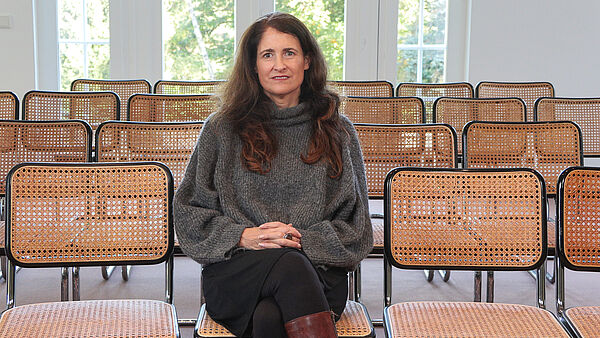
Julia A. Clarke, Ph.D.
Professor and John A. and Katherine G. Jackson Chair in Geobiology
The University of Texas at Austin
Born in 1973 in San Francisco, Cal., USA
B.A. in Geology-Biology from Brown University, Ph.D. in Geology from Yale University
Project
Biological Innovation and the Evolution of Birds
My research has long centered on evolutionary innovation. I am interested in how key traits of living organisms are assembled in deep time. My early research centered on traits related to locomotion, feathers, flight, and the co-option of a wing for underwater diving. More recently, I have focused on systems related to visual and vocal communication. For the past five years, I have led a group focused on the evolution of the avian vocal organ and co-led several projects around the acquisition of the most ubiquitous form of avian coloration. My career has so far afforded me little scope for review and synthesis.My proposed research is driven by interests in the following questions: How do new structural solutions arise on ontogenetic and evolutionary timescales? Why do new structures arise for use-contexts in which there are already structures fulfilling these functions? Is this indeed a special case of biological novelty? Are there trade-offs between structural complexity and neurological-control complexity determining a biological innovation solution space? Can acquisition of learned behaviors reduce the selective advantage of encoded function in peripheral organs? Is there a minimum complexity in a peripheral organ that must arise prior to the acquisition of related complex neural control functions? Does increasing use-contexts drive structural complexity or neural flexibility? Are these distinct selective trajectories?
During my stay, I would like to build on my work from the past 20 years and more than 130 publications on the evolution of complex traits in dinosaurs, including birds, and work to more deeply locate these findings in the broader schema of the literature on the nature of innovation and form-function relationships from diverse disciplines. Recent reviews of dinosaur evolution have been written by paleontologists focusing primarily on extinct non-avian dinosaurs without a strong research focus on living dinosaur (bird) anatomy and behavior. There has been so much new to discover in the evolution of birds by looking down into the deep history of dinosaurs from the tips of branches on which “perch” living bird species.
Recommended Reading
Clarke, Julia A., Daniel T. Ksepka, Rodolfo Salas-Gismondi, Ali J. Altamirano, Matthew D. Shawkey, Liliana D’Alba, Jakob Vinther, Thomas J. DeVries, and Patrice Baby (2010). “Fossil Evidence for Evolution of the Shape and Color of Penguin Feathers.” Science 330: 954–957. https://doi.org/10.1126/science.1193604.
Clarke, Julia A., Sankar Chatterjee, Zhiheng Li, Tobias Riede, Federico Agnolin, Franz Goller, Marcelo P. Isasi, Daniel R. Martinioni, Francisco J. Mussel, and Fernando E. Novas (2016). “Fossil Evidence of the Avian Vocal Organ from the Mesozoic.” Nature 538: 502–505. https://doi.org/10.1038/nature19852.
Longtine, Charlie, Chad M. Eliason, Darcy Mishkind, ChangHee Lee, Michael Chiappone, Franz Goller, Jay Love, Evan P. Kingsley, Julia A. Clarke, and Clifford J. Tabin (2024). “Homology and the Evolution of Vocal Folds in the Novel Avian Voice Box.” Current Biology 34: 461–472.e7. https://doi.org/10.1016/j.cub.2023.12.013.
Colloquium, 11.02.2025
Finding a Voice: an Excavation of Concepts of Human and Non-Human Songs and Singers
Where is the voice located? Who has a voice? What is the relationship between voice, song, and language? How do we track the evolution of the instruments of voice and their acoustic products? The last of these questions has motivated my study of vocal organs primarily in reptiles including birds. In this colloquium, I first share how “song” is used in the contemporary literature on animal vocalization. I then trace its history. Song was long discussed exclusively as a feature of some birds and humans. Scientific literature now also uses it to describe selected vocalizations in some mice, whales, bats, primates, insects, and frogs. Birdsong over the past 50+ years has also been a key system for illuminating primarily the neural bases of vocal production learning—of which the most studied instance is the acquisition of language in humans. In tracing the history of animal singing, I attempt to destabilize the naturalness and utility of naming some vocalizations “song” and others “not song” in the context of the study of evolution. I argue that the arc of most prior work on bird vocal production, and the identification of song more generally, has been strongly influenced by select conceptions of song from very human, European contexts. I close by showing what we may be missing by treating song and non-song as useful natural categories. Finally, I close by presenting how this affects specifically the inference of the evolution of vocal production in reptiles in concrete ways.
Publications from the Fellow Library
Clarke, Julia A. (London, 2024)
Homology and the evolution of vocal folds in the novel avian voice box
Clarke, Julia A. (Amsterdam [u.a.], 2023)
Clarke, Julia A. (Washington, DC, 2021)
Clarke, Julia A. (Oxford, 2021)
Clarke, Julia A. (Washington, DC [u.a.], 2020)
Cassowary gloss and a novel form of structural color in birds
Clarke, Julia A. (London [u.a.], 2020)
Clarke, Julia A. (London [u.a.], 2018)
Elaborate plumage patterning in a Cretaceous bird
Clarke, Julia A. (Washington, DC, 2018)
Identity and novelty in the avian syrinx
Clarke, Julia A. (New York, NY [u.a.], 2016)
Clarke, Julia A. (London [u.a.], 2016)
Köpfe und Ideen 2025
Of the Songs of Dinosaurs
a portrait of Julia A. Clarke by Gerald Wagner

